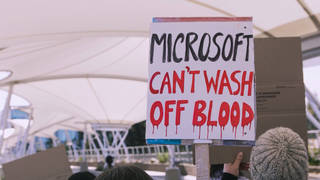
Topics
Guests
- Theodore Postolprofessor of science, technology and national security policy at the Massachusetts Institute of Technology. He is a physicist at the university and an expert in missiles, missile defenses and other aspects of modern warfare. His recent article in the Bulletin of the Atomic Scientists is called “The Evidence That Shows Iron Dome Is Not Working.”
Part two of our interview with acclaimed MIT physicist Theodore Postol, who says there is no evidence Israel’s Iron Dome missile defense system is actually working. He estimates the Iron Dome, which is partially built by Raytheon, intercepts just 5 percent of rockets fired at Israel.
Click here to watch part 1 of interview.
AMY GOODMAN: This is Democracy Now!, democracynow.org, The War and Peace Report. I’m Amy Goodman. Defense Secretary Chuck Hagel has urged Congress to approve Israel’s request for an additional $225 million in U.S. funding to strengthen the Iron Dome. Hagel asserted the air defense system has saved countless Israeli lives since the start of the operation in Gaza. He wrote, quote, “On behalf of the Administration, I ask for your support in meeting Israel’s critical missile defense needs in light of the ongoing conflict in Gaza.”
While the U.S. media, news anchors, pundits, politicians have extolled the efficacy of the Iron Dome in deflecting the thousands of Hamas rockets that put Israeli lives at risk, our guest says the opposite is actually true, that Iron Dome is more like an Iron Sieve. We’re joined by Professor Ted Postol. He is a professor of science, technology and national security policy at the Massachusetts Institute of Technology. He is a physicist and an expert in missiles and missile defense.
We’re doing part two of this interview, Professor Postol, because what you are saying flies so much in the face of almost all of the media coverage of Iron Dome, and I’m wondering if you can—well, you could take us back to a previous Israeli assault on Gaza when there wasn’t Iron Dome. And how does what’s happening today compare with when Iron Dome wasn’t there?
THEODORE POSTOL: Well, these comparisons are a little tricky, because the defense system that’s saving so many—well, saving lives in Israel is the early warning and sheltering system. And the early warning system has been improved through the use of telephones. So, for example, if you’re in a city somewhere where the Israeli radars determine that an artillery rocket is heading in your direction, you will get an audible signal that says you need to take shelter. And then there’s a shelter system that’s been built in advance all over these areas of Israel, plus you would have a shelter in your home, if you are actually in your home. So all you would need is 10 seconds of warning or less to get in a shelter in your home, and you could actually get to shelters very quickly on the outside, because these shelters are all over the place where the population is dense and the Israeli government has predicted there will be a likely attack.
AMY GOODMAN: Let me quote from Reuters, July 10th: “Israel’s Iron Dome interceptor has shot down some 90 percent of Palestinian rockets it engaged during this week’s surge of Gaza fighting, up from the 85 percent rate in the previous mini-war of 2012.” Professor Postol, your response?
THEODORE POSTOL: Well, first of all, I am sorry to say that the press needs to engage in more due diligence on these matters. Where does this number come from? The number comes from an Israeli spokesperson. Now, if I give a number—and, incidentally, I have a long record of being correct on these matters—you don’t hear the press coming to me and asking me, do I believe that number is correct? And if I don’t believe the number is correct, why would I not believe the number is correct? This is really—you can really put this back on the due diligence of the press with regard to this matter. They’re just not—they’re just accepting information from an interested party.
AMY GOODMAN: So can you explain further how this works, how the Iron Dome—how Raytheon built this?
THEODORE POSTOL: Well, the Iron Dome is mostly an Israeli development, although Raytheon is involved. The Iron Dome interceptor has to approach an incoming artillery rocket head-on. So if you saw an Iron Dome interceptor flying a near-vertical trajectory, that would indicate the Iron Dome interceptor is in a near-head-on engagement geometry coming at the artillery rocket. In that geometry, the interceptor has some chance of destroying the artillery rocket warhead. If you see the Iron Dome interceptor engaging the artillery rocket from the side or from the back by chasing it, then it has essentially a zero chance of destroying the artillery rocket warhead. So, if you look up in the sky and you look at the hundreds of videos we now have of the contrails of the—the smoke trails of the Iron Dome interceptors, you can see that almost all the time—there are exceptions, but almost all the time—the Iron Dome interceptors are traveling parallel to the ground, which means that the falling artillery rocket is engaged from the side, or the Iron Domes are—the Iron Dome interceptors are diving to the ground, which means that they are trying to chase artillery rockets from behind. All those engagements are zero probability of intercept. And we’re guessing—we’re guessing, based on what we have, that maybe 10 percent or 15 or 20 percent of the engagements are head-on. Actually, it’s not 20 percent; it’s closer to 10 percent. And when you see so few engagements head on, your conclusion is that the system is not working the vast majority of the time. Now, when you—
AMY GOODMAN: But this goes—
THEODORE POSTOL: When you have—go ahead.
AMY GOODMAN: This goes to the issue of the proportionality of the attack on Gaza. You know, more than 1,300 Palestinians have been killed. And so often when this issue is raised—and I think it’s three Israeli civilians, and of course every death is horrific on either side. But when this issue is raised, Israel just says, “Well, we have an extremely effective Iron Dome system.” If it’s not Iron Dome, is it simply saying that these rockets that Hamas and other groups are firing off, they’re not working? I mean, if their intention is to kill, that they are not lethal weapons, if so few people have died and Iron Dome isn’t working?
THEODORE POSTOL: Well, one has to realize—you know, one has to know some simple technical facts. First of all, most artillery rockets are carrying warheads in the 10-to-20-pound range. So if you’re sitting in a room and the rocket comes through the roof and explodes in the room, it will kill you, and it will kill everybody else in the room. If you have 10 seconds or 20 seconds of warning and you go into the shelter that’s, by law, built in your home, and the rocket happens to hit your home, you won’t be killed. It can even hit the shelter, and you won’t be killed. So, sheltering and early warning are extremely critical to keeping the death toll down. Now, the odds of an artillery rocket going through the roof and into your room are very low. They’re high enough that if I were in Israel, I would advise you, and I would do so myself: I would take shelter, because there’s—you know, the inconvenience is small relative to being killed or injured. But most of these rockets are landing in open areas, landing between buildings, landing outside buildings. And the real danger is that this relatively low-lethality warhead lands within 10 or 20 feet of you.
Now, if you just lie on the ground—let’s say you’re caught in the open, and you can’t go to a shelter—the Israeli government itself will tell you that your chances of being a casualty from a falling artillery rocket are reduced by 80 percent—80 percent—if you simply lie on the ground. And the reason for that is the lethal range of these low-weight warheads is not very large, and they are blowing fragments out sort of like a shotgun, and if you get close to the ground, unless you’re very unlucky and the thing lands on you or lands very close to you, you’re not going to be injured by the explosion. So, although these artillery rockets are fantastically disruptive, with regard to the functioning of Israeli society—and I think that that is true, and because of that, there’s a psychological and political leverage associated with these artillery rocket attacks—they are not killing people, as long as people are taking shelter and sheltering is available.
AMY GOODMAN: Professor Postol, I’m looking at a Boston Globe piece on the Iron Dome and Raytheon being a key in the Israeli defense plan. And it says, “For Raytheon, the Israeli contracts—part of a 'coproduction' deal with Israel’s Rafael Advanced Defense Systems—present a potential financial windfall. Much of the work would be done at Raytheon’s Tucson, Ariz., missile systems plant, as well by subcontractors across the country.” Can you talk more about exactly what Raytheon does and if this Iron Dome system is now being sold to other countries?
THEODORE POSTOL: Well, I’m not aware of sales to other countries at this point. I haven’t been following that part of the issue. On the question of foreign aid, in this case to Israel, it’s very common—it’s almost always the United States government requires that foreign aid largely be spent with—using American companies. And in the case of Raytheon, they are the premier company for basically building missiles and interceptors of all kinds. So, it’s a natural business arrangement for Raytheon to be a big beneficiary of an agreement like that, because the money goes to Israel in a virtual way, but it basically is spent in the United States.
Now, this brings—this raises the question of the cost of these interceptors. The Israelis are saying—some Israelis are saying that the interceptors cost $20,000 each. Now, the reason for lowballing this number—I’ll give you a sense of what it could cost—is because the interceptors, the Iron Dome interceptors, are intercepting rockets that might cost $500 or $1,000 each. So there’s an issue of how much you should pay, assuming the system is working, for stopping an artillery rocket, especially if the passive defense, if the taking shelter, saves lives. And, you know, for example, how many artillery shells cause $20,000 or $100,000 worth of damage. And the actual cost of an Iron Dome interceptor is almost certainly well over $100,000, not the $20,000 that some Israeli sources seem to be saying. Now, just to give you a sense of how off the cost could be—again, we don’t know at this point—another interesting fact, there’s so much we don’t know, yet people are throwing money at this. There’s a comparable missile in its cost called the Sidewinder. It’s an air-to-air missile that Raytheon manufactures and sells. The Iron Dome interceptor is very close to an air-to-air missile. It’s a very small missile, weights about 200 pounds, and so does this air-to-air missile—different design, though. That costs $400,000 each. So how is it possible to build an interceptor that has the same advanced technology—it’s not exactly the same, but similar—and roughly the same size, and it only costs $20,000 each? There’s a significant question there about whether the Congress and the American people have accurate information about what this system is really costing.
AMY GOODMAN: So you’re raising very serious questions about the effectiveness of Iron Dome. Hundreds of millions of dollars—in fact, more than the Obama administration has asked for—is being discussed in Congress to pour into this.
THEODORE POSTOL: Yes.
AMY GOODMAN: Mainly to Raytheon and other U.S. companies. Have you been called by anyone in Congress to testify, to raise your concerns?
THEODORE POSTOL: Of course not. Congress is not interested in information. What I can tell you, I have not been directly involved, but I have been privy to discussions with members of Congress who have oversight responsibilities, who have acknowledged in those discussions that they have no idea whether Iron Dome is working or not. And I can also tell you that the U.S. government has not been given any information on the performance of Iron Dome. So, when Susan Rice, the national security adviser, makes a statement about how well Iron Dome is working, somebody should ask Susan Rice what’s her source, because I can tell you that there—and she should have a source. She should be able to tell you, you know, “We had the following national laboratory take the data from the Israelis. They looked at it. And let me tell you, this thing is working well.” Instead, she gets on television and talks about this working well. Somebody should ask her, somebody in the press corps should do their due diligence and ask her, “Where did you get this information?”
AMY GOODMAN: Well, I mean, it’s not just Susan Rice, the national security adviser. It’s President Obama himself. This is what President Obama said.
PRESIDENT BARACK OBAMA: There’s no country on Earth that can be expected to live under a daily barrage of rockets. And I’m proud that the Iron Dome system that Americans helped Israel develop and fund has saved many Israeli lives.
AMY GOODMAN: That’s President Obama.
THEODORE POSTOL: Again, Mr. Obama should be able to answer the question of which American technical institution has obtained the data from the Israelis and verified the accuracy of the data and verified that the performance levels are what they are. I know that the Israelis have the data. They have radar data. They have video data in the visible. They have video data in the infrared. They have substantial amounts of data that they could and should make available to the United States, to our technical institutions, and have this data reviewed and certified. And any politician, whether it’s the president or his national security adviser, who makes a claim that this system is performing that well, should be able to point a finger at the specific agency that has the technical resources to review this data and has obtained this data from the Israelis. This is just an outrage.
AMY GOODMAN: Theodore Postol, I want to thank you very much for being with us, professor of science, technology and national security policy at the Massachusetts Institute of Technology, a physicist, an expert in missiles and missile defense. We’ll link to your piece in the Bulletin of the Atomic Scientists that’s headlined “The Evidence That Shows Iron Dome Is Not Working.”
THEODORE POSTOL: Thank you very much.
AMY GOODMAN: This is Democracy Now!, democracynow.org, The War and Peace Report. I’m Amy Goodman.











Media Options